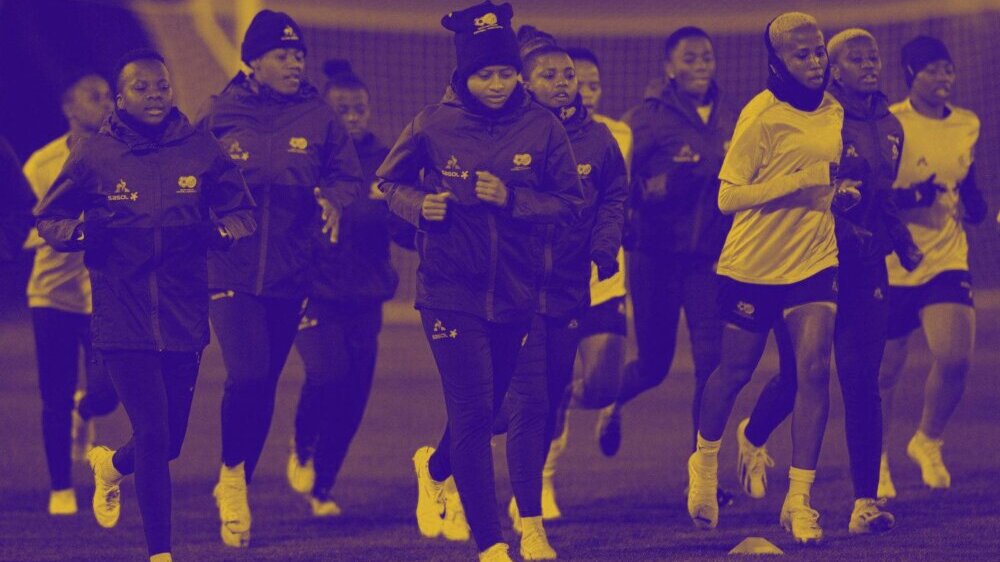- South Africa is one of four African countries participating in the 32-team Fifa Women’s World Cup 2023
- Africa is almost equal to Europe in terms of Fifa member countries, but has a third of the representation at this year’s tournament
- Africa is the only continent without pro football for women
The 2023 Fifa Women’s World Cup, which kicks off on 20 July, promises to be the biggest one yet. Jointly hosted by Australia and New Zealand, the ninth edition of the global showpiece is expected to attract record audiences, with Fifa having laid down the tracks towards improving the women’s game.
This year’s tournament will feature 32 teams, six more than in 2019 and the same number as the men’s World Cup in Qatar in 2022. (The number of teams will increase to 48 for the men’s 2026 edition.)
Federations will be paid at least $1.56-million by Fifa for participating in the tournament. The winning federation will be paid an additional $4.29-million.
Fifa will also pay players three times more than it did in 2019, bringing its total spend on the tournament to $152-million. Each player will receive a minimum participation fee of $30,000 (about R535,000). The amounts increase as teams progress, with the winning team’s players receiving $270,000 each.

The players’ prize
The total prize money for the Women’s World Cup is still way below the $440-million that Fifa paid male players at the World Cup in 2022. Fifa president Gianni Infantino has said that the association aims to pay equal prize money for the men’s and women’s tournaments by 2027.
There is no mechanism to directly pay the players the money, which would be life-changing for some. A day before kick-off, Fifa president Gianni Infantino reportedly said the association ‘could not guarantee’ that federations would distribute the payments to players.
Lagging behind
Most club footballers in Africa are not professional players and don’t earn a salary. This is the case in South Africa, where most of the players have to have other jobs. This prevents them from being able to dedicate their full energies towards the game.
It also affects the continent’s performance and representation at the World Cup. Fifa awards slots based on the relative strengths of a confederation’s teams. Although Africa is almost equal to Europe in terms of Fifa member countries, it has a third of the representation at the tournament.

The furthest Africa has gone in the competition was in 1999 when Nigeria reached the quarterfinals.
This year, Africa will be represented by:
- Nigeria, who have played in all nine editions of the competition
- South Africa, who became the African champions when they beat Morocco 2-1 in the Women’s Africa Cup of Nations (Wafcon) last year. It is Banyana Banyana’s second appearance at the World Cup
- Morocco and Zambia, who make their debuts this year
Small but mighty wins
While the women’s game is largely unprofessional in Africa, it is much better supported in Europe. Its organised football programmes for girls at the development level is a gap that the Confederation of African Football (Caf) has yet to address.
There’s a difference in public support too. In Europe, viewership for women’s sports programming has rocketed to above pre-pandemic levels, whereas the game is largely ignored in Africa.
A few steps in the right direction have been taken since the last World Cup in 2019:
- South Africa has managed to export some key players to international leagues, which has significantly improved the quality of the team. With a squad largely built around its exports, Banyana Banyana managed to clinch the 2022 Wafcon title
- The South African Football Association launched the Hollywoodbets Super League in 2019. This 16-team national women’s football league filters teams through to regional and continental football competitions, giving players much-needed exposure and game time
- The Caf Women’s Champion’s League was founded in 2022. Africa’s top women’s club football teams now face each other annually, as the men have done for decades. This is a stepping stone towards professionalising African women’s football
- Morocco and Zambia’s debut at the World Cup is the result of the investment that their federations have put in at all levels of their football

From the next club football season, African clubs will no longer be able to participate in intercontinental club competitions unless they have a women’s team participating in a Caf-sanctioned league.
This decision is part of Caf’s latest club licensing regulations, which are aimed at increasing participation and investment in women’s sport. This could go a long way to increasing our representation on the world stage.
Backing Banyana Banyana
Although South Africa heads into the competition as African champions, they are the lowest-ranked team in their World Cup group. Placed 54th in the latest Fifa Women’s rankings, they will play third-placed Sweden in their opening match, followed by Italy (16) and Argentina (28).

South Africa is coached by three-time Caf Women’s Coach of the Year Desiree Ellis. Key players in the squad include 2022 Wafcon goalkeeper of the tournament Andile Dlamini, in-form attackers Linda Motlhalo and Jermaine Seoposenwe, as well as new Banyana Banyana captain Refiloe Jane.
Nigeria is Africa’s highest-ranked team at 40, while Morocco and Zambia occupy positions 72 and 77 respectively.
